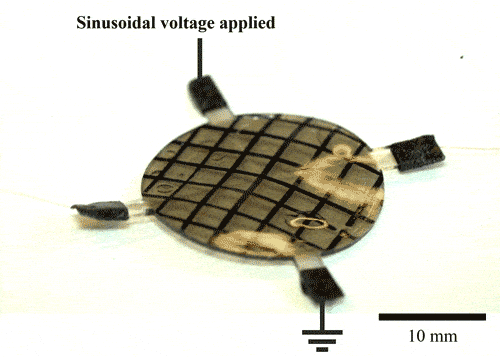
The team at the Harvard John A. Paulson School of Engineering and Applied Sciences (SEAS) can change the shape of the elastomer using actuation claimed to be fast, reversible, controllable by an applied voltage, and reconfigurable to different shapes.
The research was published in Nature Communications.
"We see this work as the first step in the development of a soft, shape shifting material that changes shape according to electrical control signals from a computer," said David Clarke, the Extended Tarr Family Professor of Materials at SEAS and senior author of the paper. "This is akin to the very first steps taken in the 1950's to create integrated circuits from silicon, replacing circuits made of discrete, individual components. Just as those integrated circuits were primitive compared to the capabilities of today's electronics, our devices have a simple but integrated three-dimensional architecture of electrical conductors and dielectrics, and demonstrate the elements of programmable reconfiguration, to create large and reversible shape changes."
According to SEAS, the reconfigurable elastomer sheet is made up of multiple layers. Carbon nanotube-based electrodes of different shapes are incorporated between each layer. When a voltage is applied to these electrodes, a spatially varying electric field is created inside the elastomer sheet that produces uneven changes in the material geometry, allowing it to morph into a controllable three-dimensional shape.
Different sets of electrodes can be switched on independently, enabling different shapes based on which sets of electrodes are on and which ones are off.
"In addition to being reconfigurable and reversible, these shape-morphing actuations have a power density similar to that of natural muscles," said Ehsan Hajiesmaili, first author of the paper and graduate student at SEAS. "This functionality could transform the way that mechanical devices work. There are examples of current devices that could make use of more sophisticated deformations to function more efficiently, such as optical mirrors and lenses. More importantly, this actuation method opens the door to novel devices that deemed too complicated to pursue due to the complex deformations required, such as a shape-morphing airfoil."
In this research, the team also predicted the actuation shapes, given the design of the electrode arrangement and applied voltage. Next, the researchers aim to tackle the inverse problem.





Project to investigate hybrid approach to titanium manufacturing
What is this a hybrid of? Superplastic forming tends to be performed slowly as otherwise the behaviour is the hot creep that typifies hot...